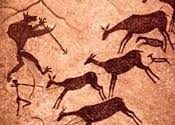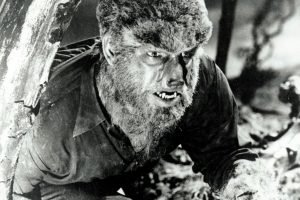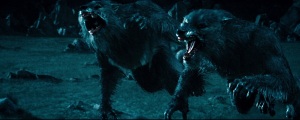At the start of the week, I introduced you to Heidi Angell, author of the Hunters Saga, and fellow urban fantasy writer. Today I bring you the second of two stops I’m hosting on The Hunted tour.
I originally offered to host this particular post, because it’s a subject very close to my heart, writing about shapeshifters myself. It’s also a topic Heidi and I have discussed from time to time, and our discussions have always left me with new insights into the whatever topic we’ve covered. So, when Heidi said she had this idea for a stop on her blog tour, I jumped at the chance to host it.
What you’re about to read is a very insightful piece that covers many aspects of mythology, medical diagnosis, and legends from ancient times right up to modern day. Please read until the very end, and visit some of the other stops on the tour.
A Brief History of Werewolves: From Cave Paintings to The Hunters Saga
 The “History” of werewolves is a strange thing indeed. It might even predate written history. There are many ancient cave paintings that appear to depict werewolves and other human/ animal composites.
The “History” of werewolves is a strange thing indeed. It might even predate written history. There are many ancient cave paintings that appear to depict werewolves and other human/ animal composites.
Every culture has a variation on the theme of shapeshifters, werewolves, and other were-creatures, but the oldest written tale of actual men turning into wolves goes back to ancient Greece and the tale of King Lycaon, who Zeus turned into a werewolf after the man was foolish enough to try and trick Zeus by feeding him human flesh.
Tales such as Little Red Riding Hood show our fear of wolves eating humans, and may explain many “Werewolf serial killer cases” throughout European history, such as the 1589 case of Peter Stumpp, the Werewolf of Bedburg. Indeed, many of the werewolf cases where the men (why is it always men? It certainly isn’t in legend.) were convicted based on evidence that these men did indeed kill and consume the flesh of their victims. Were they truly Werewolves, or were people linking the two fears?
There is even a rare psychological diagnosis of clinical lycanthropy, in which a person is afflicted with the delusion that they are or have changed into an animal. The patient will exhibit animalistic behaviors, but no physiological change has ever been noted.
 There is a genetic condition, often referred to as Werewolf Syndrome that causes massive growth of hair in unusual parts of the body, and is known to be hereditary.
There is a genetic condition, often referred to as Werewolf Syndrome that causes massive growth of hair in unusual parts of the body, and is known to be hereditary.
And with all of this to muddle about in, there comes into play the legends. The oldest legends involved it being a curse on the man in some cultures (like King Lycoan) or the work of the Devil. Perhaps this is why people throughout history tended to have a softer spot for werewolves than for vampires. Other tales have it that the afflicted was harnessing the animal power through a magic girdle made from a wolf’s pelt, through spirit magic, ( such as in Norse mythology, the legends of Ulfhednar, who were similar to berserkers, but dressed in wolf pelts and channeled the fighting power of the wolf during battle.) or even through Saintly Divine intervention ( such as the story of St. Natalis, who cursed an illustrious Irish family with the result that each member of it was doomed to be a wolf for seven years).
 The stories of werewolves being forced to change with the moon, and only being able to be killed by silver are relatively modern concoctions of fiction, with little reference prior to the 1600s. But the idea of some being born as a werewolf, and made as a werewolf have deep roots.
The stories of werewolves being forced to change with the moon, and only being able to be killed by silver are relatively modern concoctions of fiction, with little reference prior to the 1600s. But the idea of some being born as a werewolf, and made as a werewolf have deep roots.
And of course, in modern paranormal romance, the idea of shifters who’s transitions are not as agonizing and who’s forms are more true to their animal counterparts, also brings a whole other wealth to pull from.
In The Hunters Saga, the Weres are of two groups: Made-Weres (based on the legends of those bitten by a werewolf, who are changed because of it.) and Born-Weres (families of genetically born werewolves who transition in puberty) and I pull from all the legend and history, twisting it all into the tale, which in future books we will see in more depth as we learn the origins of vampires and werewolves.
Want to learn more? The Hunters Saga is an urban fantasy series for those who believe that vampires should be killed not kissed. The tour for the second book in the series, The Hunted, is in full swing, and we would love for you to join in. See the tour master list here.
You can get a free copy of the first book in the series, The Hunters, by subscribing to my weekly e-newsletter full of bookish news from all genres. Subscribe Here
The Hunted releases February, 18 th. Join the release party Here on February 17th-19th on Facebook.

